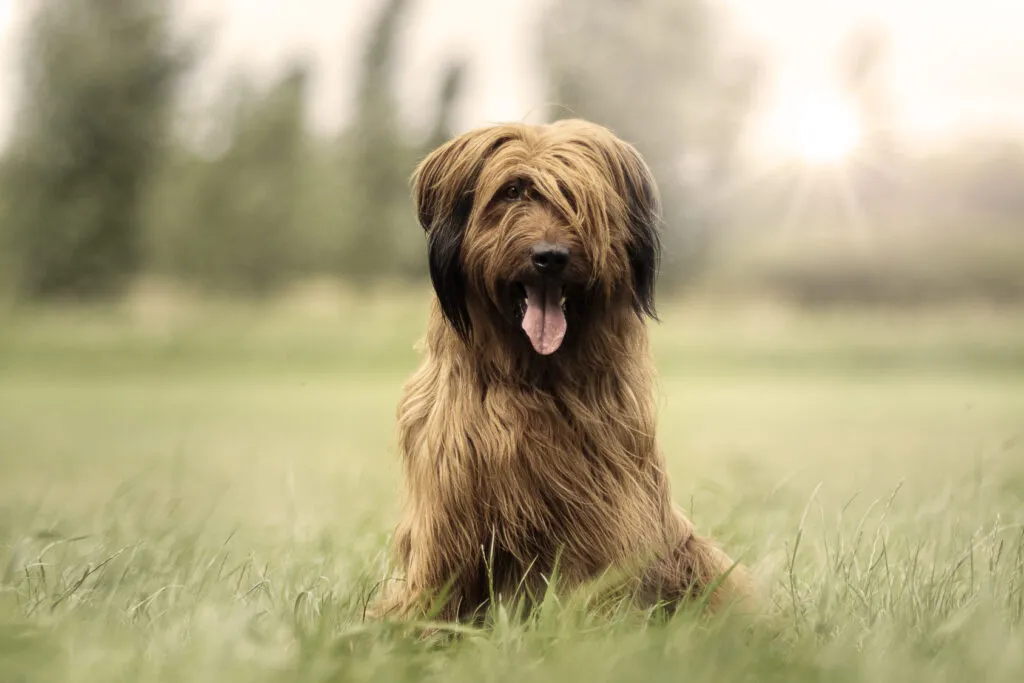Medium Size Poodle
The elegant, medium-sized Briard with its long, curled hair and friendly nature is a popular family dog today. However, due to its wilfulness and temperament, this former herding dog needs experienced hands.

© carmenrobert / stock.adobe.com
The Briard combines herding instincts with loyalty, protecting its family with courage and humor while staying closely bonded to its pack
Balanced, affectionate, good with children and loyal – no wonder that the herding dog from the French lowlands is also very popular as a family dog. However, its pronounced wilfulness and insatiable need for movement and activity can sometimes make its training a challenge.
The qualities of a herding dog are evident in the Briard – also known as Berger de Brie. Its independence, intelligence and alertness are remarkable. It meets strangers with inherent suspicion and would bravely and without hesitation confront intruders – after all, this fearless four-legged friend used to face wolves to protect its flock.
As a family dog, it has retained this natural protective instinct and sometimes exhibits humorous traits when it tries to keep its human pack together on walks. Even though it is closely bonded to its reference person, it prefers to have its entire family around. If someone is missing or a member leaves the group “unlawfully”, the affectionate French dog can become restless.
Given its pronounced family sense, it is difficult for the breed dog to cope with being alone. As an owner of a Briard-puppy, it is advisable to practice separations early, as there will be times when you cannot take your dog with you.
However, you should generally try to undertake as much as possible together. The Briard is not a dog that can be kept “on the side”. Attending a dog sports school, extended walks in nature, joint jogging sessions and bike tours, or even training as a tracking, rescue or therapy dog, are a must for every Briard owner.
When sufficiently exercised, the sporty and enduring four-legged friend will be calm and balanced and become a very loving and reliable companion who will go through thick and thin with its family.
The fact that the Berger de Brie is not a dog that can simply be “left on its own” is also proved by its striking appearance. Its stately height of up to 68 cm, well-proportioned body and lush long coat make it an imposing figure.
Characteristic is the “curled” coat, which forms long strands all over the body – even on the head. Despite the rather light undercoat, the lush fur provides reliable protection in all weathers.
The fur colour of the Briard is black, grey or fawn (fawn/fauve). In the latter variant, a black charbonnage in which the hair tips appear black is allowed. White markings, however, are not permitted.
The strong head with the distinct stop carries a long moustache and beard and prominent eyebrows. The rather short hanging ears, which were previously cropped, are also covered with long hair. Its equally hairy sickle-shaped rod, which hangs low when standing, can form a line with the back when in motion.
Another peculiarity of the Berger de Brie breed is the double dewclaws, which should be set as low as possible on the hind legs. This relic of its past is now rather a hindrance, especially in sports, increasing the risk of injury and should therefore be kept short.
Although its exact origin can no longer be traced today, the Briard undoubtedly belongs to one of the oldest French shepherd dogs. It probably descends from farm, herding and yard dogs of the French lowlands and developed its breed-specific traits through a cross between the Picard and the Barbet.
Descriptions that match the French shepherd dog can be found in records dating back to 1387. However, it is first mentioned by name as “Chien de berger de Brie” only in 1785.
The impressive herding dog, whose original tasks included herding and hunting, first appeared at a dog show in 1863. However, the Briard breed was officially recognised only about 30 years later. The first official standard appeared in 1897. The Briard owes its breed’s continued existence not least to its tireless service as a patrol, messenger and medical dog in the two World Wars. The fact that the Briard achieves high results in sporting competitions is not surprising given its history.
 © slunicko24 / stock.adobe.com
© slunicko24 / stock.adobe.com
Despite its excellent traits and versatility, the Briard is still relatively unknown outside its homeland. Those interested in a Berger de Brie-puppy may need to be patient. This has the positive effect that you have enough time to calmly consider the purchase of this charming, but demanding dog.
Do you have enough space for this active dog? Are you yourself physically active? Do you have enough time to engage with this bundle of energy? Do you already have experience in dog-keeping and dog training? Are all family members in agreement with having a dog? If you can answer these questions with “yes”, then the Briard could indeed be the right breed for you.
When making your purchase decision, be sure to contact a reputable breeder who breeds according to FCI standards, meets the necessary breeding requirements and has carried out all the necessary examinations.
But not only on a formal level, the breeder should also suit you personally. Don’t just take the “first one” who happens to be nearby. After all, the breeder should be there to support you with advice and assistance for some time after the purchase. Tapping into the knowledge of an experienced Briard breeder and consulting them on issues that only arise when living with the dog can be gold and often saves you the long search for other dog experts.
The price for a puppy should be at least £1000. Offers significantly below this are unreliable and usually come at the expense of the dog’s health.
Since the Briard is fortunately free from fashion breeding, the risk of encountering unscrupulous or profit-hungry breeders is relatively low. It may also be worthwhile to visit an animal shelter where some Briards may have ended up because their previous owners could no longer meet the keeping requirements. You might even find one there and give a dog in need a new home.
If you are already the proud owner of a purebred Berger de Brie, you need hardly fear hereditary diseases. The Briard is fortunately a very robust breed with a relatively long life expectancy of approx. 12 years.
However, a weak point of the Briard – like many dogs of its size – is the hip. Although the risk of hip dysplasia (HD) has been reduced thanks to strict breeding regulations, you should still ensure that the joint is not overburdened, particularly during your dog’s growth phase. Excessive climbing of stairs or very long bike rides should be avoided during the puppy stage.
In some cases, eye diseases (PRA and CEA) and the MDR1 defect, which can lead to intolerances to certain medications, can also occur. Therefore, be sure to keep up with regular check-ups with your vet, as this is the only way to detect and treat diseases early.
Equally important for your dog’s health is, of course, the care at home. Especially the coat care should not be underestimated with a Briard. Despite the light undercoat, the long, curled hair tends to mat quickly and should therefore be brushed every other day.
Once or twice a week, you should take at least an hour to thoroughly comb through its shaggy coat, removing dirt and loose hair. Avoid cleaning with dog shampoo as much as possible, as this will unnecessarily soften its robust coat. Bathing in natural waters is, of course, allowed and can be done as often as it likes.
To make the somewhat arduous coat care easier for you and your dog, you should establish fixed care rituals from puppyhood if possible. Get your young dog used to staying still during combing and associate the procedure with something positive.
For example, comb it in the evening when it is lying in front of you on the couch, and you are giving it loving strokes anyway. If it manages to stay still, a treat is also allowed after combing. Once you have found a suitable time for the extensive care, stick to it. A fixed rhythm gives your dog security and ensures that it can relax during the care.
Fixed times are also recommended for feeding. Dogs have a sense of time and quickly internalise when it is time to eat, go out or sleep. This gives them structure and prevents excessive begging outside of feeding times. While a puppy is still fed three to four times a day until the 16th week of life, the number of meals decreases over time.
Between the fourth and ninth months of life, you should feed your young dog three times a day; from the ninth month, two fixed meals a day are sufficient.
 © michaelstephan / stock.adobe.com
© michaelstephan / stock.adobe.com
When choosing the right food for your Briard, many factors play a role. Besides costs, purchase and preparation options, the ingredients of the food should be the deciding factor. Depending on age, activity level, weight and health status, dogs need different nutrient compositions. Therefore, it is not possible to make a general statement about which food is best for your Briard at home. Talking to your vet or a dog nutritionist can help find a dog food whose nutrients and vitamins are perfectly tailored to your dog’s individual needs.
Essentially, your Briard’s food should have a high protein content in the form of high-quality meat (approx. 70%) and a high vegetable content (approx. 20-30%). Grain should make up a max. 10% of the ingredients. Sweeteners like sugar, artificial flavour enhancers and unnecessary fillers do not belong in dog food. Also, make sure to provide your dog with enough fresh drinking water – it should always be available, not just during set meal times.
The greatest contribution to your dog’s “well-being” is its keeping, in addition to care and nutrition. Meeting the needs of a Berger de Brie is not always easy. The former herding and hunting dog needs a lot of space, plenty of exercise and a lot of activities to be satisfied. It loves any form of physical activity where it can demonstrate its temperament and incredible endurance.
It goes without saying that this breed dog is not a suitable partner for homebodies. As a Briard owner, you and your family should not only have a house with a large, fenced garden but also enjoy sporty outings.
Joint bike tours, jogging sessions or horse riding trips are well suited to meet the physical and mental demands of your dog. The daily walks should be as varied as possible. With retrieval games, search tasks, teaching little tricks or romping with other dogs on a dog meadow, you can avoid monotonous repetitions and boredom during your walks.
You should be aware that the Briard, as a former working dog, definitely needs a meaningful task. In addition to walking, cycling or jogging together, visiting a dog sports school is highly recommended. Thanks to the versatility of this French breed dog, there are countless possibilities in dog sports. Whether as a tracking dog, in agility, in tournament or protection dog sports – the Briard excels in almost all dog sports.
Read our articles on Dog Agility & Games!
Sports not only ensure your dog’s good fitness but also more balance on a mental level. Learning the exercises together also promotes mutual trust between you and your dog, creating an invaluable basis for harmonious coexistence with your four-legged friend.
The Briard is one of the more challenging breeds to train due to its stubbornness and wilfulness. However, with sufficient physical and mental activity, you can prevent it from seeking undesirable tasks on its own. This makes the Briard more willing to follow your training exercises, commands and orders.
You’ll notice that keeping and training a Briard require a lot of commitment, time and consistency. But the effort is worth it: in the right hands, the good-natured and friendly Briard becomes a dog partner who gives back incredibly much not only during shared sporting activities but also on a mental level. It is not without reason that the Berger de Brie is increasingly used as a therapy dog.
Fans of the Bearded Collie agree that those who aren't familiar with this dog breed simply have to get acquainted with it. And those who have experienced how a Bearded Collie bolts across meadows with its flowing fur, how it rolls around full of energy and joy and how it attentively and observantly takes into account its owners wishes become simply addicted to this original dog breed and its unique charm.
The Goldendoodle isn't a breed, but a pairing between Golden Retrievers and Medium or Standard Poodles. Marketed as a low-maintenance dog for allergy sufferers, this hybrid is enjoying increasing popularity amongst dog lovers, similar to the Labradoodle.